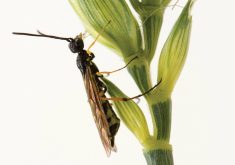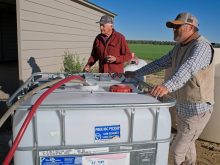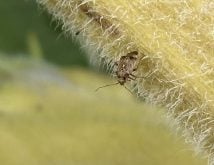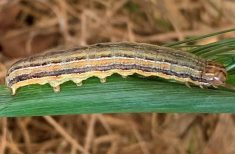When scouting for insects in your fields next year, it’s not only crop-devouring pests you should keep an eye out for. That’s because insect predators like ground beetles as well as parasitic wasps and flies can take a big chunk out of pest populations.
“It’s important to recognize there are a lot of natural enemies that naturally occur and are present in our crop environment,” says Jordan Bannerman, an entomologist with the University of Manitoba.
He says a good example is a tiny wasp called Banchus flavescens, which has been observed parasitizing more than 40 per cent of bertha army worm populations in some years.
Read Also

Claas brings 1000 Series SP forage harvesters to Canada
In mid-August, Claas unveiled its new line of Jaguar forage harvesters at an event in Visalia, California, deep in the heart of that state’s dairy region.
Bannerman maintains beneficial insects like B. flavescens “do good work, but it’s not always going to be enough to prevent outbreaks of certain pests.
“Generally speaking, they are always acting to reduce pest populations. Now in certain years and certain places, that does not mean that outbreaks won’t happen. But they are our first line of defence in helping keep our potential pests at subeconomic levels.
“Our real guidance when it comes to controlling pests is to make sure the pest population is at or above the economic threshold before you consider any other type of intervention like spraying an insecticide,” Bannerman adds.
“Any time you can get away with not spraying, you’re going to be helping support the long-term populations and the long-term benefit provided by these natural enemies.”
Predators and parasitoids
Bannerman stresses it’s important to try to recognize natural enemies when scouting for pest populations.
“You will get a general sense of what’s there, and this is going to help improve your awareness and make you more cognizant of them when you’re making pest management decisions.”
These natural enemies fall into two camps: insect predators that eat other insects and insects that attack and eventually kill other insects as parasites, sometimes by eating them from the inside out.
“There’s quite a diversity of both predators and parasitoids that we find associated with most of our economic pests or potentially economic pests,” says Bannerman.
“If you’re working in the industry or if you’re producing yourself, there are good resources and fact sheets about a lot of these different beneficial insects.”
These resources can be found on numerous ag websites. These include the following:
Here are a few pest insect predators and parasitoids to watch for in the coming crop year.
Ground beetles
Bannerman says there is a variety of very important beetle groups that feed on insect pests. One is ground beetles, which are very abundant in crop environments in the Prairies.
“They are really pretty much present in all of our different crops,” he says. “These are soil surface predators and, by and large, they are quite general in what they feed on. They will kill and consume other insects very opportunistically.”

Bannerman notes ground beetles will help control potential pests like caterpillars that spend any amount of time on the ground, or even those that just get blown off of the plants and onto the ground.
“One of the nice things about ground beetles is how long they are active,” he says, noting different species will be active at different times of the year.
This means there’ll be ground beetles around to prey on cutworms early in the spring and then on other pests that emerge throughout the growing season.
“There are also at least a few species that will feed on weed seeds as well, which is a nice bonus,” says Bannerman.
He says ground beetles are easy to recognize. “They tend to be black or brown, anywhere between five millimetres and two centimetres long.”
From a scouting perspective, Bannerman says it’s important to keep in mind ground beetles spend all of their time on or in the soil.
“Many of our species are nocturnal, so if you are looking for ground beetles, you generally need to get down on the ground, and during the day your best bet is looking through stubble, cracks, anywhere where there are places for them to hide.”
Lady beetles
Lady beetles are an important natural enemy of crop pests, particularly of aphids.
“Lady beetles are one of the two most important natural enemies of most of our aphids in our various crops,” says Bannerman, adding the other is parasitic wasps.
“By and large, they like to feed on soft-bodied insects — basically small insects that don’t have a really hard exoskeleton. That makes them really some of the best aphid predators,” he says.
“There are 66 species of lady beetles in Manitoba, and most of those species primarily will be feeding on aphids.”

Bannerman notes lady beetles, which also eat insect eggs, can be found feeding on aphids in whatever crop has enough food to support them. For this reason, they move around freely.
“You will observe them in any crop where you’re already scouting for aphids,” he says. “They are going to be right on the plants, and they will be concentrated where the aphids are, where their food is.”
According to Bannerman, using a sweep net is “very effective for scouting lady beetles and assessing how many you’re seeing.”
He says most adult lady beetles are recognizable. “They are primarily red or orange, but they will also have some level of black and white markings on them.”
Lady beetles at the larval stage are also predatory. Bannerman says they resemble alligators in shape and tend to be black or gray. They’ll generally have orange or white spotting or marks on them as well.
Wasps
Parasitoid insects are primarily wasps and flies. According to Bannerman, many that benefit Prairie crops have favourite insects they prey on.
“We can’t necessarily say they only attack a single species, but they generally attack a fairly narrow range.”

One example of a parasitoid wasp species is Diadegma insulare. Bannerman notes it’s one of the most important natural enemies of the diamondback moth, a common insect pest in canola.
“Diamondback moths don’t overwinter here, so every year the abundance of diamondback moth is quite variable. This parasitoid also blows in, and it can often build its own populations very high,” he says.
“They operate by laying eggs directly into the caterpillar stage of the diamondback moth. Those eggs will hatch and then the larvae will essentially kill the moth by consuming it from the inside out.”
Bannerman says the adult wasps are only about three millimetres long, making them very hard to identify at a species level.

He adds the best way to assess whether these wasps are present in your fields is to collect a few diamondback moth caterpillars and put them in a container for a few days. Affected caterpillars will die as the wasp pupae emerge from their bodies.
Flies
Athrycia cinerea is a species of tachinid fly that more than pulls its weight when it comes to battling bertha army worms.
“This single fly species has been documented as killing as much as 20 per cent of a bertha army worm population, so it is very effective,” says Bannerman.

“It lays its eggs onto the body of a small bertha army worm caterpillar, that egg hatches, and then the little fly larva will actually get inside the bertha army worm and start to feed internally,” he adds. “It is the larva developing inside the caterpillar that is responsible for killing the army worm.”
Bannerman says most parasitoid flies and wasps, in addition to being so small, tend to be nondescript.
“Most parasitoids are difficult, if not impossible, to identify in the field,” he says. “They’re not things that are necessarily recognized by a lot of the people scouting fields, so oftentimes we recommend looking for signs of parasitoid activity, which you can often observe in the pests that you’re monitoring.
“This would include things like looking for aphid mummies, which are little brown or white or black dead aphids that are a sign they were killed by a parasitoid.”
Another sign are eggs laid by parasitoid flies, which they will glue onto the body of a host caterpillar. This signals that the caterpillar won’t survive to be an adult moth.
Bannerman notes parasitoid wasps will spin little silky cocoons as they transition from larva to adult, which is another sign of parasitoid activity in a field.
“It’s something to be cognizant of when you are thinking about potential management of pests like army worm,” he says.

Protecting beneficial insects
Bannerman stresses farmers can be proactive in protecting predator and parasitoid populations. Here are some management practices that can help.
Use selective insecticides
“Even with natural enemies present, there may still be pest outbreaks requiring insecticide applications,” says Bannerman. “We encourage the use of selective insecticide products when available or when relevant to help minimize negative impacts and help support natural enemy populations long term.”
He says a variety of products are available to Prairie producers that do not necessarily kill all insects. These include insecticides that control pests like bertha army worm and diamondback moth but have a minimal or reduced effect on beneficial insects.
Bannerman cites Coragen (active ingredient is chlorantraniliprole) as one example.
“It has a very good activity and is registered for a number of crop pests, including grasshoppers, and a variety of lepidopterans. It does have reduced impact on some of our beneficial groups like our predators and parasitoids.”
Bannerman says BTK biological insecticides are “also quite useful in that they are very selective and effective for some pests and have minimal to little impact on their natural enemies.”
Consider insecticide-resistant crops
Options of insecticide-resistant crops include Bt corn, which is enhanced by biotechnology to protect against corn borer and corn rootworm. Bannerman says resistant varieties like this reduce reliance on insecticides and benefit natural enemy groups as a result.
Provide favourable habitats
“Many of our beneficial predators and parasitoids do better in environments when there are pollen and nectar sources available, which can provide additional energy,” says Bannerman.
“They also will do better in environments where there are relatively undisturbed areas and can act as a refuge for when resources aren’t available in the crop environment.”
Bannerman says in addition to providing alternative food sources in the spring and fall, places like ditches, riparian areas and shelter belts are often excellent overwintering sites for many of these insects.
“We have to recognize a lot of our natural enemy species don’t spend their entire lives in the crop environment, so it’s important to maintain these relatively undisturbed spaces.”
Reduce insecticide spray area
Bannerman says another useful practice is to take a more targeted approach to insecticide applications so that more beneficial predators and parasitoids can be spared.
During a bad grasshopper year, for example, farmers could opt to focus on ditches, where the first flushes of grasshoppers typically emerge, with their initial sprays.
“This way, you are reducing the actual area that is being sprayed with potentially a broad-spectrum insecticide. Again, any time you can reduce exposure of these beneficial insects to insecticides is going to be beneficial,” says Bannerman.
Avoid tillage
Reducing tillage can be beneficial for some types of beneficial insects. Bannerman says that’s particularly true for surface predators like ground beetles, which spend part of their life cycles overwintering within the soil.
“Reduced disturbance of the soil can also help support those populations long term,” he says.
















